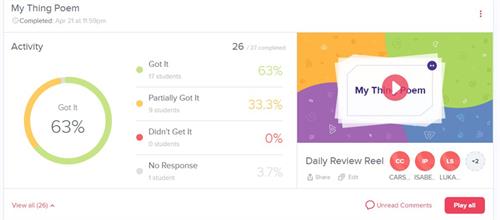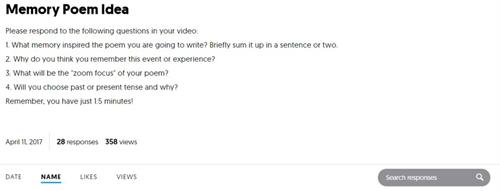 Teachers know from experience that quality student talk in a classroom improves depth of thinking and reflection. Organizations including the Association for Supervision and Curriculum Development (ASCD) and the National Board for Professional Teaching Standards (NBPTS) encourage teachers to use the power of student talk through best practices like teacher–student conferencing, literature circles, Socratic seminars, and student-led parent–teacher conferences. Lately I’ve extended that power through two video tools that facilitate robust student-to-teacher and student-to-student exchanges: Recap and Flipgrid.
Teachers know from experience that quality student talk in a classroom improves depth of thinking and reflection. Organizations including the Association for Supervision and Curriculum Development (ASCD) and the National Board for Professional Teaching Standards (NBPTS) encourage teachers to use the power of student talk through best practices like teacher–student conferencing, literature circles, Socratic seminars, and student-led parent–teacher conferences. Lately I’ve extended that power through two video tools that facilitate robust student-to-teacher and student-to-student exchanges: Recap and Flipgrid.
With Recap, students record videos up to two minutes long in response to assigned prompts. My eighth-grade students recently shared ideas for a poem in which they were to use personification or apostrophe. In their Recaps, they explained how they planned to incorporate the devices and why they chose them and then assessed their own understanding. A comment stream below the video allowed me to dialogue with students about their ideas and self-assessments. Finally, I compiled four responses into a “Daily Review Reel” to illustrate the various ways these literary devices might be used.
Recap allows unlimited classes and students and is currently free. Pictured is a teacher view of a single set of responses; students see only their own responses, not their classmates’.

With Flipgrid’s free version, teachers create prompts with text or video and students respond in up to 90-second videos. Flipgrid offers automatic transcription as an added feature but does not provide a self-assessment tool. Unlike Recap, students can view their classmates’ responses. With the Flipgrid upgrade, students can record responses to classmates’ videos and connect with other students around the world through the Global Connections page.
Teachers can assess responses using a built-in performance rubric. The free version allows only one class but unlimited prompts and students, whereas the upgrade allows unlimited classes. I recently used the upgraded version of Flipgrid to hold a poetry slam. This removed performance pressure and upgraded the quality of final performances.

What else can a teacher do with a tool like Recap or Flipgrid? The list below includes some of the ways my students have interacted using these tools.
To build classroom community, students have...
- Shared introductions
- Introduced others (parents, siblings, grandparents, pets) to classmates
- Shared places or favorite things with classmates
- Shared personal stories
In the writing process, students have...
- Shared writing ideas
- Discussed prewriting plans
- Asked for targeted feedback on drafts
- Shared final pieces and responded to others
In the reading workshop, students have...
- Recorded and shared book talks
- Summarized assigned reading, jigsaw style
- Performed oral interpretations of favorite poems
- Posed questions about words, ideas, or concepts that confused them
- Shared interpretations or analyses of assigned reading
With group discussions students have...
- Suggested essential questions to begin a Socratic seminar
- Summarized the central takeaway of a discussion
- Critiqued a discussion and offered suggestions for improvement
There are other ways to combine apps for video sharing, but I find the seamless efficiency of programs like Recap and Flipgrid to be game-changers. Both provide apps for multiple platforms and are intuitive to use. Most important, they amplify student talk in new and exciting ways.
 Angie Johnson is a doctoral student in Educational Psychology and Educational Technology at Michigan State University. She teaches eighth-grade language arts and is a media and technology integration specialist at Lakeshore Middle School in Stevensville, MI.
Angie Johnson is a doctoral student in Educational Psychology and Educational Technology at Michigan State University. She teaches eighth-grade language arts and is a media and technology integration specialist at Lakeshore Middle School in Stevensville, MI.